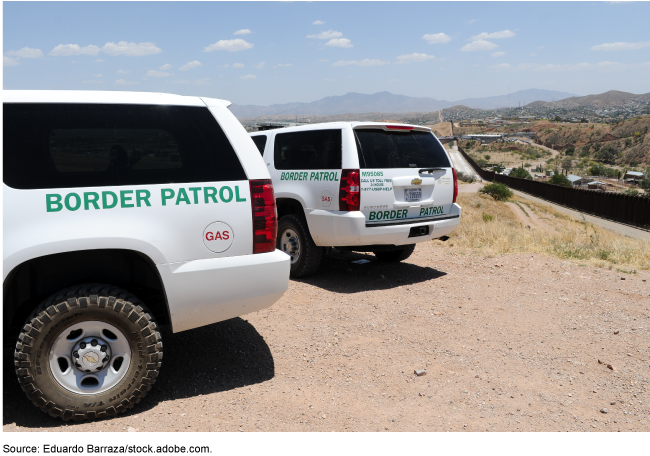Border Security: Border Patrol's Missing Migrant Program
Fast Facts
U.S. Border Patrol's Missing Migrant Program helps rescue migrants in distress, prevent migrant deaths, and recover human remains along the southwest border.
Border Patrol must submit annual reports to Congress on this issue, including data on migrant rescues and deaths. In April 2022, we found that Border Patrol hadn't collected, recorded, or reported to Congress complete data on migrant deaths.
As of March 2024, the agency has implemented 2 of our 3 related recommendations and made some progress on the third. That one was about discussing data limitations in Border Patrol reports to help Congress and the public better understand the data.
Border Patrol vehicles stationed near the Mexico–United States border in Nogales, Arizona

Highlights
What GAO Found
Border Patrol established the Missing Migrant Program in 2017 to help rescue migrants in distress and reduce migrant deaths along the southwest border. Through this program, Border Patrol coordinates with external entities (e.g., state and local officials) to assist migrants in distress and to recover and identify remains.
Border Patrol sector agents are responsible for collecting and recording data on migrant deaths. In April 2022, GAO reported that Border Patrol had not collected and recorded, or reported to Congress, complete data on migrant deaths. Specifically, GAO reported that while Border Patrol has a policy for recording information on migrant deaths in the agency's system of record, Border Patrol sectors had not entered all available information on migrant deaths into the system consistent with that policy. In particular, GAO found that Border Patrol was not recording all migrant deaths in instances where an external entity first discovered the remains.
Border Patrol agreed with GAO's recommendation that it take steps to ensure it collects and records available information on migrant deaths, including those identified by external entities. Border Patrol has implemented the recommendation by taking steps to revise its guidance, meeting with sectors and reviewing their program reports, and coordinating with external entities.
In its August 2023 report to Congress on migrant deaths, Customs and Border Protection provided data for fiscal years 2018 through 2022 on migrant deaths. However, the report does not include a discussion of data limitations as GAO previously recommended. For instance, officials from one sector told us that large land areas along the border, sometimes combined with hazardous terrain, make it difficult to discover all remains, leading to some migrant deaths going unreported. More specifically, in April 2022, GAO reported that Border Patrol had not reported to Congress complete data on migrant deaths or disclosed limitations with the data it reported. GAO recommended that Border Patrol include known migrant deaths, including those reported by external entities, and any data limitations in public agency reports and those to Congress. Border Patrol agreed with this recommendation and has taken some steps toward addressing it. To fully address the recommendation, Border Patrol should include data limitation disclosures in its annual reports to Congress. By including data limitations in its reports, Border Patrol could provide context for Congress and the public to better understand data on migrant deaths.
Border Patrol has also taken steps to evaluate the Missing Migrant Program. In April 2022, GAO found that Border Patrol collected and reviewed information about program activities; however, it did not have a plan to evaluate the program overall. GAO recommended that Border Patrol develop a plan with time frames to evaluate the program. Border Patrol agreed with GAO's recommendation and implemented it. Specifically, in November 2023, Border Patrol provided a plan for evaluating the Missing Migrant Program that notes that headquarters will review the program every 6 months. A Border Patrol official told us that the first reports from sectors based on the evaluation plan were expected in March 2024. It includes activities that are intended to help Border Patrol monitor and improve the Missing Migrant Program.
Why GAO Did This Study
U.S. Customs and Border Protection (CBP), within the Department of Homeland Security, is the lead federal agency responsible for border security. U.S. Border Patrol, within CBP, is responsible for securing the U.S. border between ports of entry to prevent individuals and goods from entering the U.S. illegally. In fiscal year 2022, Border Patrol reported a record number of migrant deaths—approximately 900—and the rescue of about 22,000 migrants.
The Missing Persons and Unidentified Remains Act requires CBP to submit annual reports to Congress that include, among other elements, the number and location of unidentified remains found along the southwest border. In response, Border Patrol submitted its most recent report to Congress in August 2023. The Act also includes a provision for GAO to review how CBP collects data on migrant deaths and how CBP works with external entities in cases involving missing migrants or unidentified remains. This report addresses (1) the actions Border Patrol has taken to collect and record available information on migrant deaths; (2) Border Patrol's reporting on migrant deaths and the extent to which data limitations are included; and (3) Border Patrol's efforts to evaluate the Missing Migrant Program.
GAO analyzed Border Patrol documentation and interviewed officials at Border Patrol headquarters, four field locations, and one external entity. GAO selected the field locations to reflect a range in the number of reported migrant deaths, types of terrain, and interactions with external entities. This report supplements information and draws from GAO's April 2022 report (GAO-22-105053) and November 2022 correspondence (GAO-23-106007) on the Missing Migrant Program. It also describes Border Patrol's efforts to address GAO's prior recommendations.
For more information, contact Rebecca Gambler at (202) 512-8777 or gamblerr@gao.gov.
